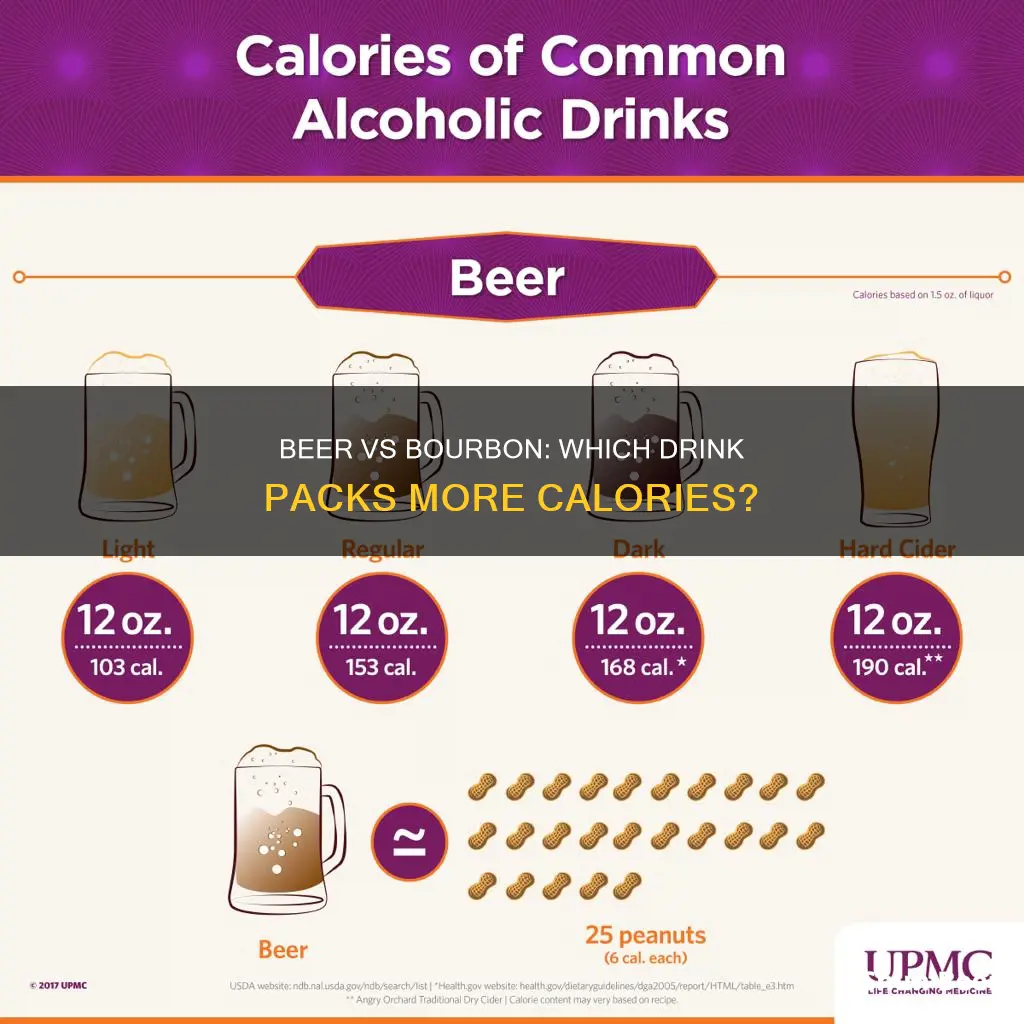
Alcoholic drinks are known to be high in calories and low in nutritional value. Spirits, such as bourbon, and beer are two of the most popular alcoholic drinks, but which has more calories? A standard 12-ounce beer contains around 150 calories, while a shot of spirits, such as bourbon, contains around 97-120 calories. Therefore, beer contains more calories per serving. However, it's important to note that the calorie content of alcoholic drinks can vary depending on their alcohol content, volume, and the presence of carbohydrates and sugars.
What You'll Learn

Bourbon vs beer calories
Alcoholic drinks are known to be high in calories and low in nutritional value. The calories in alcoholic drinks come from alcohol, which contains 7 calories per gram, and carbohydrates. The amount of alcohol, the total volume of the beverage, and the amount of carbohydrates and sugars all influence the calorie count.
Calories in Beer
Beer is made from grain, which stores carbohydrates in the form of starch. The starch is broken down into smaller sugar molecules during the brewing process, and these sugars are then converted to alcohol by yeast. However, some larger starch molecules remain, which cannot be broken down and contribute to the overall calorie count of beer. The calorie content of beer also depends on its alcohol content, with higher-alcohol beers generally containing more calories. A standard 12-ounce serving of 5% ABV beer usually has around 150 calories.
Calories in Bourbon
Bourbon is a type of whiskey, which is typically distilled from grain and aged in wooden barrels. Unlike beer, whiskey does not contain any carbohydrates or sugars. The calories in whiskey come primarily from the alcohol content, which is typically around 40-60% ABV. A shot of whiskey (1.5 ounces) typically contains around 97-120 calories, depending on the brand and alcohol content.
Comparison
When comparing bourbon to beer in terms of calories, it is important to consider the serving size. A standard serving of beer is typically 12 ounces, while a standard serving of bourbon is 1.5 ounces. Based on this, bourbon has a lower calorie count per serving. However, it is important to note that the alcohol content of bourbon is typically higher than that of beer, so the number of calories can add up quickly if you are drinking larger amounts.
In conclusion, both bourbon and beer can contribute to weight gain due to their high calorie content. If you are watching your weight, it is generally recommended to consume alcoholic beverages in moderation or choose low-calorie or reduced-calorie options.
Calories in Beer-Battered Haddock: Nutritional Breakdown
You may want to see also

Calories in pure spirits
Pure alcohol contains 7 calories per gram, which is almost as many as a gram of fat, and more than protein and carbs, which have 4 calories per gram.
Spirits such as gin, rum, tequila, whiskey, and vodka contain 97 calories per 1.5-ounce shot (40% alcohol content). These spirits do not contain any carbohydrates or sugars. Some producers may add small amounts of sugar to combat bitterness, but this does not significantly impact the calorie count.
The number of calories in a spirit will depend on its alcohol content, also known as its proof. For example, a 1.5-ounce shot of 94-proof rum has about 116 calories, while a 1.5-ounce shot of 70-proof Captain Morgan contains about 86 calories.
When comparing whiskey and vodka of the same proof, there is not much difference in calorie content. For instance, a 1.5-ounce shot of 80-proof whiskey or vodka contains 97 calories.
Liqueurs, which are sweetened, tend to have higher calories than liquors. For example, a 1.5-ounce shot of coffee liqueur has 160 calories.
It is important to note that the calories in alcoholic drinks can quickly add up when mixed with other ingredients such as soda, juice, cream, or ice cream. For example, a piña colada can have around 340 calories, while a margarita can have over 300 calories.
Light Beer: Calories or Color?
You may want to see also

Beer calories and carbs
Beer is made from grains such as barley and wheat, which contain carbohydrates. The fermentation process determines how many grains and added sugars remain in the beer. As a result, the amount of carbohydrates in beer varies.
The calorie count for a standard 12-ounce serving of one of the top 10 most popular beers in the United States ranges from around 95 calories on the low end to just under 150 calories on the high end. Light beers typically have fewer calories, ranging from 60 to 100. Regular beers with an average alcohol content of 5% have around 150 calories. Heavy hitters like IPAs, double or imperial IPAs, and Belgian-style Trippels pack 200 to 300 calories.
The American Heart Association recommends that men consume no more than two alcoholic drinks per day, and women no more than one. A standard drink is considered to be a 1.5-ounce serving of 80-proof spirits or a 4-ounce glass of wine.
People watching their carbohydrate intake may want to limit their beer consumption. Beer may not be suitable for diets that severely restrict carbohydrates. However, some light beers with very few carbs may be appropriate for less restrictive diets.
Drinking water between beers, sipping drinks slowly, avoiding drinking on an empty stomach, and choosing 'light' beers are all strategies to reduce calorie intake from beer.
Cider Beers: Which Have the Least Calories?
You may want to see also

Calories in mixed drinks
Alcoholic drinks can be loaded with calories, and mixed drinks are no exception. Cocktails mixed with soda, juice, cream, or ice cream can be particularly high in calories. A couple of drinks can add 500 calories or more to your daily intake.
A traditional pina colada, for example, can contain as many as 650 calories. A frozen margarita can be upwards of 500 calories, and an 8-ounce margarita on the rocks is around 300 calories. A mojito is typically about 160 calories, and a White Russian is around 400 calories.
Some mixed drinks are lower in calories. A vodka soda, for instance, contains 64 calories, and a rum and Coke is 130 calories. Substituting Diet Coke for Coke lowers this to 64 or 98 calories, respectively. A Moscow Mule is 138 calories, and a mimosa is around 100 calories.
The calorie count of mixed drinks can vary depending on the bartender and the specific recipe used. However, it's important to be mindful of the calorie content of alcoholic beverages, especially when watching your weight or trying to maintain a healthy weight.
SweetWater 420 Beer: Calorie Count and Nutrition Facts
You may want to see also

Alcohol and weight gain
Alcoholic drinks are high in calories and offer little to no nutritional value. A typical 12 oz. beer has as many calories as a can of Coke (140). Some have twice that amount. A 5% alcohol beer like Budweiser has around 150 calories, while heavy hitters like IPAs and double IPAs can have up to 300 calories.
On the other hand, a 1.5-ounce shot of spirits like vodka, gin, rum, whiskey, or tequila has an average of 97 to 120 calories. A glass of champagne (4 ounces) has about 84 calories, while a glass of dry wine (5 ounces) has approximately 120 to 125 calories.
While the relationship between alcohol consumption and weight gain is not entirely clear, heavy drinking may lead to weight gain over time. Alcohol may affect the hormones that control appetite, hunger, and stress. It can also reduce your blood sugar level, making you crave high-carb foods.
In addition, alcohol prevents your body from burning fat. When you're drinking alcohol, your liver breaks down alcohol instead of fat. This can lead to an increase in abdominal fat, also known as a "beer belly."
Other factors that contribute to weight gain include the amount and frequency of alcohol consumption, what you eat when drinking, your physical activity level, and your unique body and lifestyle.
To maintain a healthy weight, it is recommended to drink in moderation. This means no more than one drink per day for women and no more than two drinks per day for men. Opting for low-calorie drinks, eating before drinking, and setting limits can also help manage weight.
Beer Calories: Friend or Foe?
You may want to see also
Frequently asked questions
A standard 12-ounce beer has around 150 calories, while a shot of bourbon has around 100 calories. Therefore, beer has more calories.
The calorie count in alcoholic drinks depends on various factors, including the amount of alcohol, total volume, and the presence of carbohydrates and sugars.
Yes, low-calorie beers are available, containing about 100 calories or even as few as 55 calories per beer. However, these beers generally have a lower alcohol content. For bourbon, opting for a lower-ABV option may result in higher calories due to added ingredients and sugars.
Alcohol consumption can contribute to weight gain, and excessive drinking is associated with obesity. The Dietary Guidelines for Americans recommend moderation, with one drink per day for women and two drinks per day for men.
Yes, non-alcoholic options like seltzer water, soda, or diet cola have zero calories and can be a healthier alternative to alcoholic beverages.







